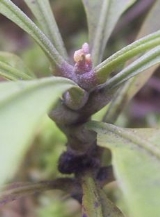
Dioncophyllaceae
Encyclopedia
Dioncophyllaceae is a family
of flowering plants consisting of three species of lianas native to the rainforest
s of western Africa.
Its closest relative is Ancistrocladaceae
. Both of these families lie within a clade of mostly carnivorous plants which since 1998 or so have been moved to the order Caryophyllales. This clade also includes the families Droseraceae
(sundews and Venus' flytrap) and Nepenthaceae (an Old World genus of pitcher plants), as well as Drosophyllaceae.
All species in the family are liana
s at some point in their life cycle and climb by the use of pairs of hooks or tendrils formed by the end of the leaf
midribs. The best known member is the carnivorous Triphyophyllum peltatum, although the family contains two other species: Habropetalum dawei and Dioncophyllum thollonii.
(1981) had placed the family in order Violales
.
The APG II system
, of 2003 (unchanged from the APG system
, of 1998), does recognize this family and assigns it to the order Caryophyllales
in the clade core eudicots.
Family (biology)
In biological classification, family is* a taxonomic rank. Other well-known ranks are life, domain, kingdom, phylum, class, order, genus, and species, with family fitting between order and genus. As for the other well-known ranks, there is the option of an immediately lower rank, indicated by the...
of flowering plants consisting of three species of lianas native to the rainforest
Rainforest
Rainforests are forests characterized by high rainfall, with definitions based on a minimum normal annual rainfall of 1750-2000 mm...
s of western Africa.
Its closest relative is Ancistrocladaceae
Ancistrocladaceae
Ancistrocladaceae is the botanical name for a family of flowering plants. Such a family has been widely recognized by taxonomists.The APG II system, of 2003 , also recognizes this family and assigns it to the order Caryophyllales in the clade core eudicots...
. Both of these families lie within a clade of mostly carnivorous plants which since 1998 or so have been moved to the order Caryophyllales. This clade also includes the families Droseraceae
Droseraceae
Droseraceae is the botanical name for a family of flowering plants. The family is also known under its common name, the sundew family.It consists of carnivorous plants: besides the sundews, the genus Drosera, it also contains the even more-famous Venus fly trap Dionaea muscipula...
(sundews and Venus' flytrap) and Nepenthaceae (an Old World genus of pitcher plants), as well as Drosophyllaceae.
All species in the family are liana
Liana
A liana is any of various long-stemmed, woody vines that are rooted in the soil at ground level and use trees, as well as other means of vertical support, to climb up to the canopy to get access to well-lit areas of the forest. Lianas are especially characteristic of tropical moist deciduous...
s at some point in their life cycle and climb by the use of pairs of hooks or tendrils formed by the end of the leaf
Leaf
A leaf is an organ of a vascular plant, as defined in botanical terms, and in particular in plant morphology. Foliage is a mass noun that refers to leaves as a feature of plants....
midribs. The best known member is the carnivorous Triphyophyllum peltatum, although the family contains two other species: Habropetalum dawei and Dioncophyllum thollonii.
History of classification
The Cronquist systemCronquist system
The Cronquist system is a taxonomic classification system of flowering plants. It was developed by Arthur Cronquist in his texts An Integrated System of Classification of Flowering Plants and The Evolution and Classification of Flowering Plants .Cronquist's system places flowering plants into two...
(1981) had placed the family in order Violales
Violales
Violales is a botanical name of an order of flowering plants and takes its name from the included family Violaceae. The name has been used in several systems, although some systems used the name Parietales for similar groupings...
.
The APG II system
APG II system
The APG II system of plant classification is the second, now obsolete, version of a modern, mostly molecular-based, system of plant taxonomy that was published in April 2003 by the Angiosperm Phylogeny Group. It was a revision of the first APG system, published in 1998, and was superseded in 2009...
, of 2003 (unchanged from the APG system
APG system
The APG system of plant classification is the first, now obsolete, version of a modern, mostly molecular-based, system of plant taxonomy that was published in 1998 by the Angiosperm Phylogeny Group. It was superseded in 2003 by a revision, the APG II system, and then in 2009 by a further...
, of 1998), does recognize this family and assigns it to the order Caryophyllales
Caryophyllales
Caryophyllales is an order of flowering plants that includes the cacti, carnations, amaranths, ice plants, and many carnivorous plants. Many members are succulent, having fleshy stems or leaves.-Description:...
in the clade core eudicots.
External links
- Dioncophyllaceae in L. Watson and M.J. Dallwitz (1992 onwards). The families of flowering plants: descriptions, illustrations, identification, information retrieval. Version: 30 May 2006. http://delta-intkey.com
- NCBI Taxonomy Browser

